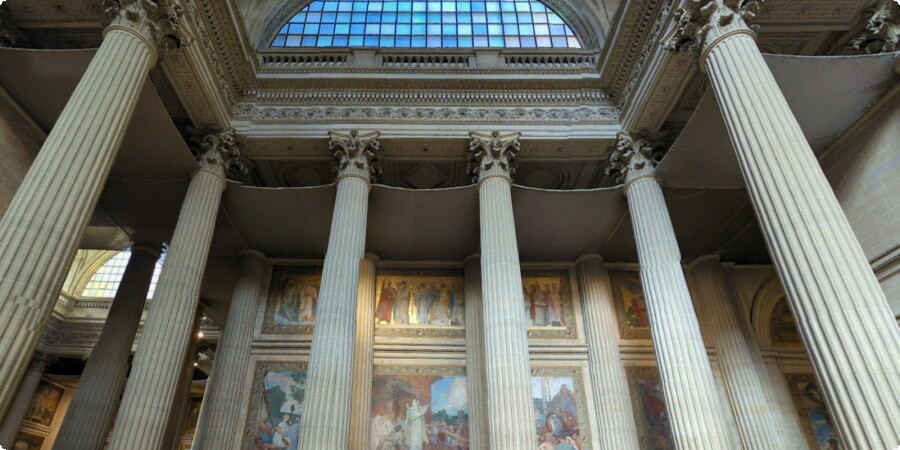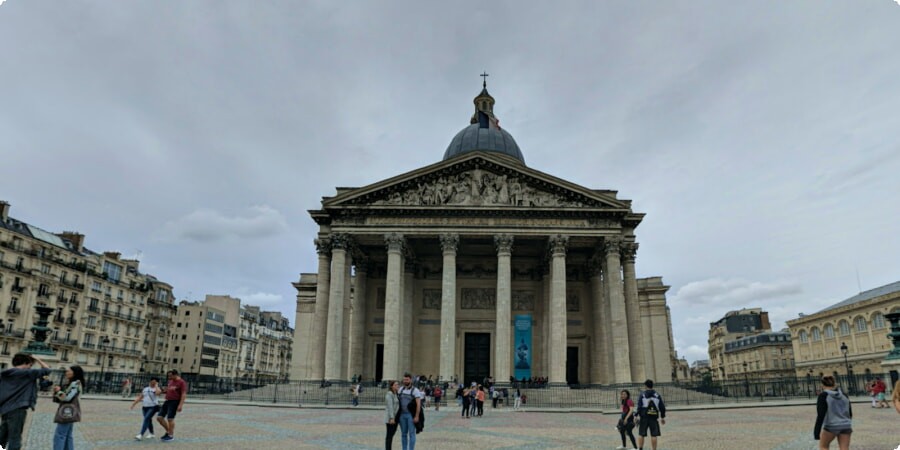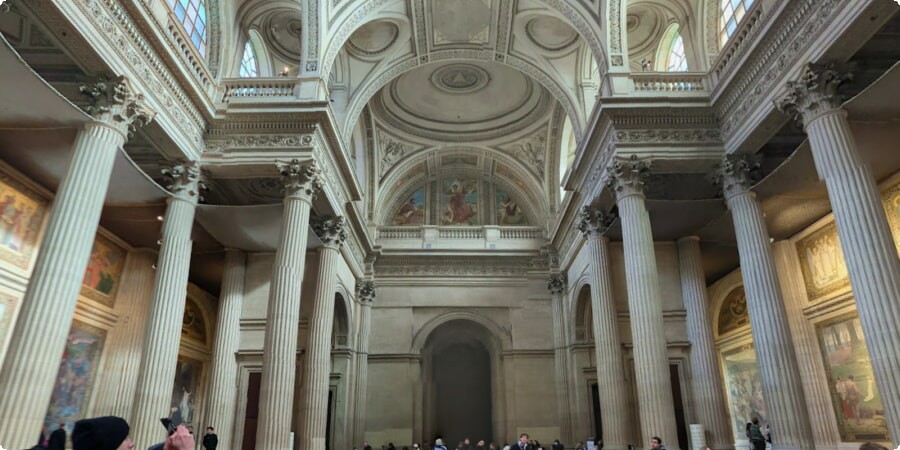A Closer Look at the Pantheon's Magnificent Architecture and Design
Welcome to the Pantheon, a majestic monument nestled in the heart of Paris. As you step into its grand courtyard and gaze up at its towering façade, you can't help but be in awe of the architectural masterpiece that lies before you. The Pantheon stands as a symbol of French identity and enlightenment ideals, a testament to the country's rich cultural heritage and intellectual legacy.
Neoclassical Inspiration
The Pantheon's architectural style is deeply rooted in neoclassicism, a movement that emerged in the late 18th century as a revival of classical Greek and Roman design principles. Inspired by the ancient temples of antiquity, neoclassical architecture sought to evoke a sense of grandeur, harmony, and order.
Architect Jacques-Germain Soufflot, the mastermind behind the Pantheon's design, drew heavily from these classical influences when conceiving the monument. His vision was to create a building that would embody the ideals of the Enlightenment and serve as a fitting tribute to the great thinkers and leaders of France.
Exterior Design Elements
The exterior of the Pantheon is a study in neoclassical grandeur, with its imposing portico, majestic dome, and intricate façade. The portico, supported by massive Corinthian columns, creates a sense of strength and stability, while the dome, crowned by a soaring lantern, adds a touch of elegance and grace.
One of the most striking features of the Pantheon's exterior is its façade, adorned with a series of sculptural reliefs and decorative motifs. These intricate details pay homage to the classical tradition while also conveying the monument's underlying themes of wisdom, virtue, and enlightenment.

As you approach the Pantheon from the bustling streets of Paris, take a moment to admire its architectural beauty and marvel at the skill and craftsmanship that went into its construction.
And if you're planning to explore more of Paris's architectural wonders, consider booking a car through Cars Scanner for convenient transportation around the city.
Interior Layout and Space
Step inside the Pantheon, and you'll be greeted by a vast and awe-inspiring interior that is both grand and harmonious in its design. The layout of the Pantheon is characterized by its spacious central nave, flanked by side chapels and adorned with majestic columns and arches.
The central nave draws the eye upward toward the magnificent dome, which rises high above, creating a sense of openness and grandeur. Light floods in through the oculus at the top of the dome, illuminating the space below and adding to its ethereal beauty.
The side chapels, with their ornate altars and intricate artwork, offer moments of quiet contemplation and reflection amidst the grandeur of the main space. As you wander through the interior of the Pantheon, take the time to appreciate the harmony and balance of its design, which reflects the classical ideals of order and proportion.
Decorative Elements
The interior of the Pantheon is adorned with a wealth of decorative elements that add to its beauty and significance. From exquisite frescoes and sculptures to intricate detailing and ornamental motifs, every aspect of the interior design has been carefully crafted to evoke a sense of awe and wonder.
One of the most striking features of the Pantheon's interior is its stunning frescoes, which adorn the walls and ceilings of the central nave and side chapels. These intricate paintings depict scenes from mythology, history, and religion, capturing the imagination and inspiring contemplation.

In addition to its frescoes, the Pantheon is home to a number of impressive sculptures, including statues of famous figures from French history and allegorical representations of virtues such as liberty, equality, and fraternity. These sculptures serve as a reminder of the Pantheon's role as a monument to the great minds and leaders of France.
As you explore the interior of the Pantheon, take the time to admire these decorative elements and appreciate the skill and artistry of the craftsmen who brought them to life.
Engineering Marvels
The construction of the Pantheon was a remarkable feat of engineering, combining innovative techniques and materials to create a structure of unprecedented scale and complexity. At the heart of the monument is its magnificent dome, which spans an impressive 83 meters in diameter and is one of the largest in the world.
Constructed using a combination of stone and concrete, the dome of the Pantheon is an architectural marvel that has stood the test of time. Its innovative design, with a series of interconnected ribs and arches, distributes weight evenly and provides support for the structure above.
In addition to its dome, the Pantheon also features a number of other engineering innovations, including its massive columns, soaring vaults, and intricate masonry work. These elements come together to create a building that is not only beautiful to behold but also structurally sound and enduring.
And if you're planning to explore more of France's architectural wonders, consider booking a car through Cars Scanner for convenient transportation around the country.
Symbolism and Meaning
Beyond its architectural magnificence, the Pantheon is imbued with profound symbolism and meaning that speaks to the values and ideals of the French Republic. Originally intended as a church dedicated to Sainte-Geneviève, the patron saint of Paris, the Pantheon was repurposed during the French Revolution as a secular mausoleum to honor the nation's heroes and intellectuals.

The inscription above the entrance, "Aux grands hommes la patrie reconnaissante" ("To great men, the grateful homeland"), encapsulates the Pantheon's primary purpose as a tribute to the individuals who have made significant contributions to French society. From scientists and writers to politicians and revolutionaries, the Pantheon honors those who have left an indelible mark on the nation's history and culture.
As you explore the Pantheon, take the time to reflect on its symbolic significance and the enduring legacy of the individuals memorialized within its walls. Their lives and achievements serve as a reminder of the values of liberty, equality, and fraternity that lie at the heart of the French Republic.
Restoration and Preservation Efforts
Over the years, the Pantheon has undergone numerous restoration and preservation efforts to ensure its continued beauty and structural integrity. From repairs to the dome and façade to conservation work on its decorative elements, these efforts are essential for safeguarding this iconic monument for future generations.
One of the most significant restoration projects in recent years was the renovation of the Pantheon's dome, which involved repairing cracks, reinforcing the structure, and restoring its original color and luster. This painstaking work required the expertise of skilled craftsmen and engineers, who carefully preserved the historic character of the monument while ensuring its long-term stability.
In addition to physical conservation, efforts have also been made to enhance the visitor experience at the Pantheon, with improvements to accessibility, signage, and educational programming. These initiatives aim to make the Pantheon more welcoming and engaging for visitors of all ages and backgrounds, ensuring that its legacy endures for years to come.

In conclusion, a visit to the Pantheon offers not only a glimpse into the architectural brilliance of the past but also a deeper understanding of the values and ideals that continue to shape the present. From its neoclassical design to its rich symbolism and storied history, the Pantheon stands as a testament to the enduring spirit of France and the individuals who have helped to shape its destiny.
As you stand beneath the Pantheon's majestic dome and gaze upon the names inscribed on its walls, take a moment to reflect on the contributions of those who have come before us and the legacy they have left behind. And remember, the Pantheon is not just a monument to the past but a living symbol of the ideals we strive to uphold in the present and future.